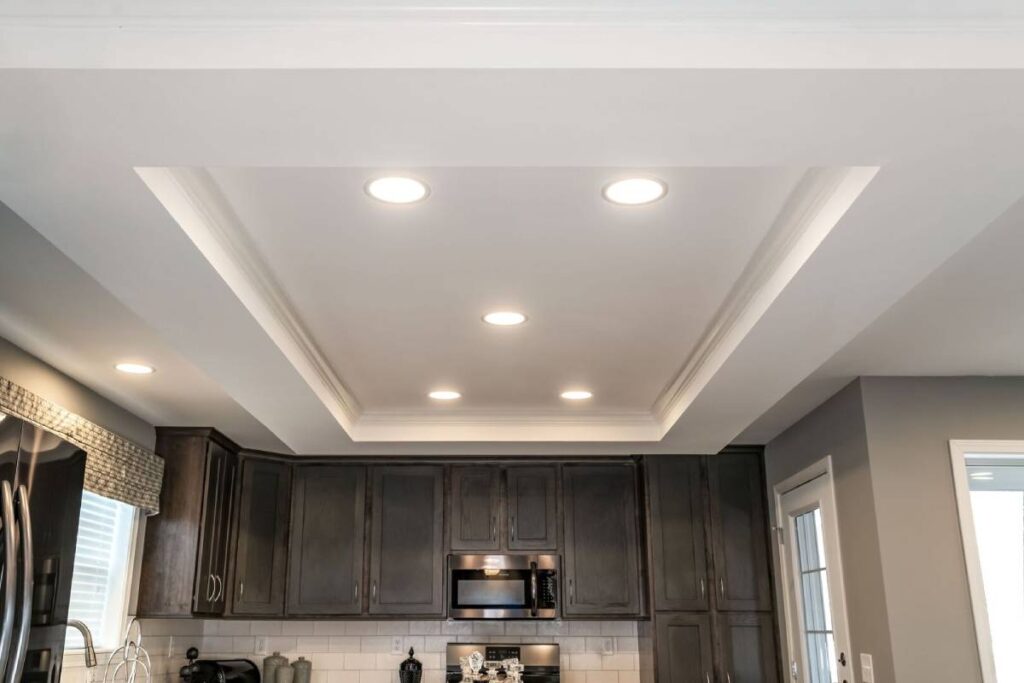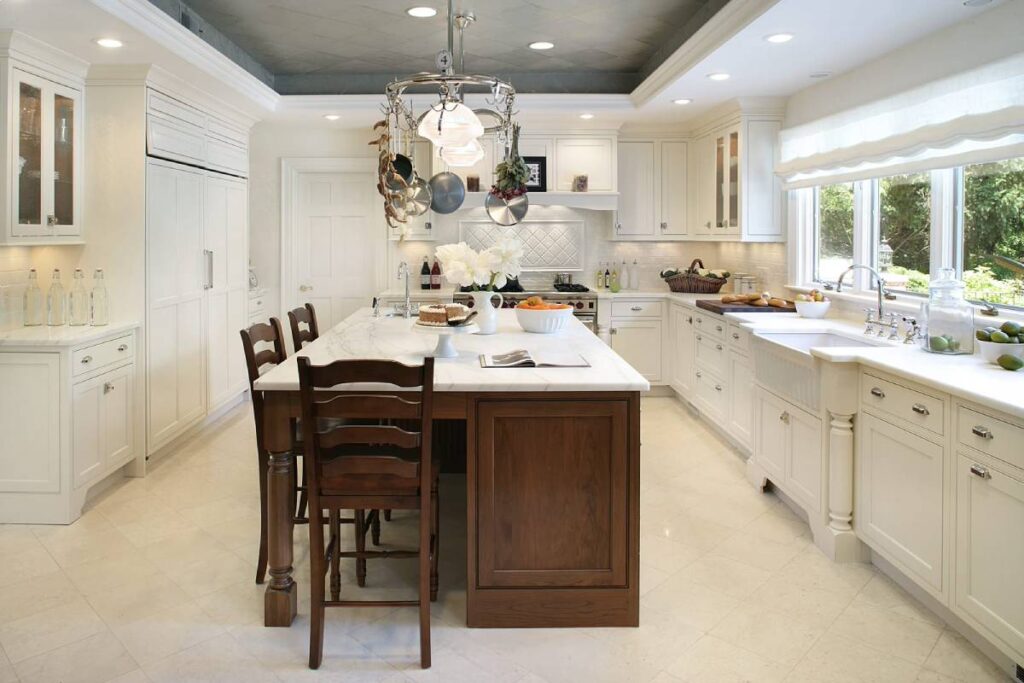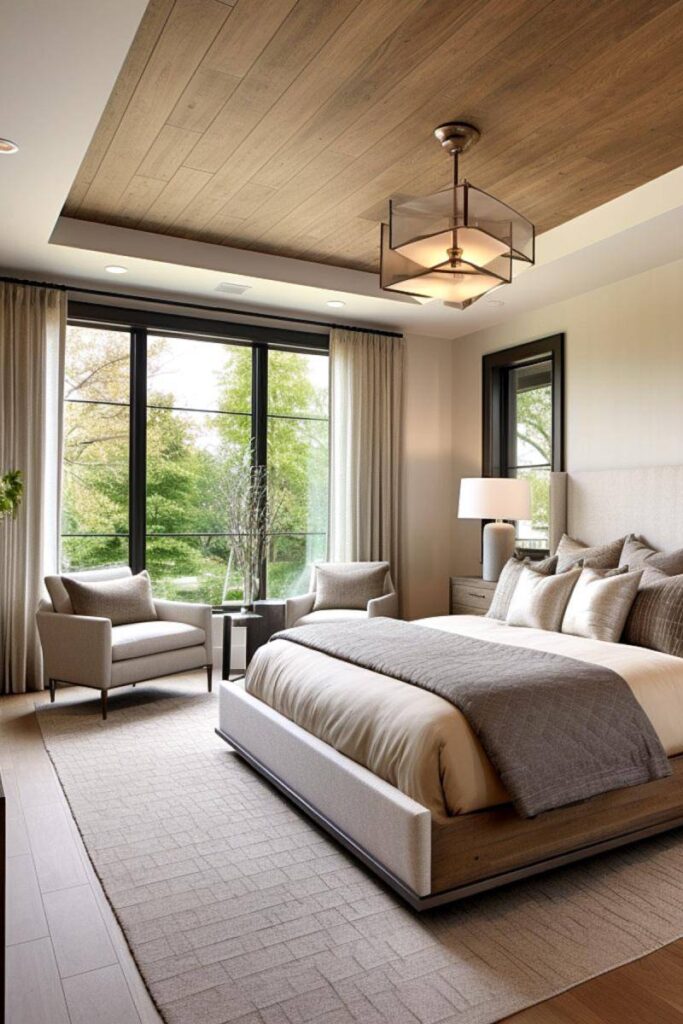Tray ceilings, also known as inverted or recessed ceilings, have become a popular architectural feature in modern interior design. These unique ceiling structures add a touch of elegance and sophistication to a room while offering various aesthetic and functional benefits.
In this discussion, we will explore the advantages and disadvantages of tray ceilings, consider their impact on the perceived size of a room, and delve into the details of what defines a tray ceiling.
Related story: What is the difference between laminated and engineered flooring? Which is more durable and can you tell the difference?
What is a tray ceiling?
A tray ceiling, also known as a recessed ceiling or inverted ceiling, is a type of architectural design element used to add visual interest and depth to a room. It is characterized by a central section that is higher than the surrounding areas, creating the appearance of an inverted tray. This design typically features a flat or slightly angled central portion, with the perimeter of the ceiling at a lower level.

Tray ceilings can vary in complexity, with some having a single step or tier and others incorporating multiple levels or intricate designs. Homeowners and designers often use tray ceilings to enhance the aesthetics of a room, create a sense of spaciousness, or add a touch of elegance. Lighting fixtures, such as recessed lights or cove lighting, are frequently incorporated into tray ceilings to highlight their architectural details and create a dramatic effect.
Tray ceilings are commonly found in various residential and commercial settings, including bedrooms, living rooms, dining rooms, and entryways. They offer a versatile design element that can complement different interior styles and add a unique dimension to the overall decor of a space.
Do tray ceilings make a room look bigger?
Tray ceilings can create an illusion of increased height in a room, which can contribute to the perception of a larger space. By having a central, raised portion in the ceiling, tray ceilings draw the eye upward and make the room feel more open. This effect is particularly beneficial in rooms with lower ceilings, as the raised central area can counteract the potential sense of confinement.
Additionally, the design versatility of tray ceilings allows for creative lighting solutions, such as recessed lights or cove lighting, which can further enhance the perception of space. Strategically placed lighting can illuminate both the central portion of the tray and the surrounding areas, adding depth and visual interest to the room.
While tray ceilings can contribute to a sense of spaciousness, it’s important to note that the overall impact depends on various factors, including the size of the room, the design of the tray ceiling, and the coordination with other elements in the space. A well-designed tray ceiling, integrated harmoniously with the room’s overall aesthetic, can be a valuable element in making a room appear larger and more inviting.

What are the advantages and disadvantages of tray ceilings?
Advantages of tray ceiling
- Architectural Interest: Tray ceilings add architectural interest and visual appeal to a room. The unique design creates a focal point that can make the space more visually interesting and sophisticated.
- Height Perception: The central, higher portion of a tray ceiling can create the illusion of greater height in a room. This can make a space feel more open and spacious, which is especially beneficial in rooms with lower ceilings.
- Lighting Options: Tray ceilings provide opportunities for creative lighting design. Recessed lights, cove lighting, or other fixtures can be installed within the tray to highlight the architectural details and create a warm and inviting atmosphere.
- Design Versatility: Tray ceilings are versatile and can be adapted to various interior design styles. Whether traditional, contemporary, or transitional, tray ceilings can complement a wide range of aesthetics.
- Room Definition: In larger open spaces, a tray ceiling can help define different areas within a room, such as distinguishing a dining area from a living space or creating a sense of separation in an open floor plan.
- Increased Property Value: Homes with well-designed and carefully executed architectural features, such as tray ceilings, may have higher resale value. These features contribute to the overall perceived quality and desirability of a property.
- Concealing Imperfections: Tray ceilings can be used to hide structural or architectural imperfections, such as irregular ceiling heights or exposed beams, by incorporating them into the design.
- Customization: Tray ceilings offer a high level of customization. Homeowners can choose from various designs, materials, and finishes to match their preferences and the overall design scheme of the room.

Disadvantages of tray ceiling
- Installation Cost: The construction and installation of tray ceilings can be more complex and labour-intensive compared to standard flat ceilings. This can result in higher installation costs, especially if intricate designs or additional structural modifications are required. The cost of ceiling installation is between $1,600 to $3,200 per project.
- Maintenance Challenges: Cleaning and maintaining tray ceilings can be more challenging due to the recessed areas and varying heights. Dust and cobwebs may accumulate in the indentations, requiring extra effort during cleaning.
- Limited Ceiling Height: In rooms with lower ceilings, a tray ceiling might not be practical as it can reduce the overall height perception, making the space feel even smaller.
- Design Clash: Poorly designed or improperly executed tray ceilings can clash with the overall aesthetic of a room or home. It’s essential to ensure that the design complements the existing decor and architecture.
- Reduced Energy Efficiency: Depending on the lighting choices and the depth of the tray, there could be increased energy consumption if the design necessitates more lighting fixtures. Additionally, the recessed areas may make it harder to install energy-efficient insulation.
- Spatial Constraints: In rooms with limited space, a tray ceiling may not be the best choice, as it can visually decrease the perceived space and make the room feel cramped.
- Not Suitable for All Rooms: Tray ceilings may not be suitable for every room in a house. For example, they might not be the ideal choice for spaces with irregular shapes or rooms where a more straightforward design is preferred.
- Trend Dependence: Design trends change over time, and a tray ceiling that was popular in one era might become dated. Homeowners should consider the long-term appeal and potential impact on resale value.
Final Thought
Tray ceilings stand as versatile design elements that can transform the ambience of a room. The advantages, from architectural interest to customizable lighting options, contribute to their popularity. However, it’s crucial to weigh these benefits against potential drawbacks like installation costs and maintenance challenges.
The impact of tray ceilings on the perceived size of a room depends on careful design considerations. Whether you opt for this design feature for its aesthetic appeal or to create an illusion of spaciousness, a well-executed tray ceiling can undoubtedly elevate the overall atmosphere of a living space.

